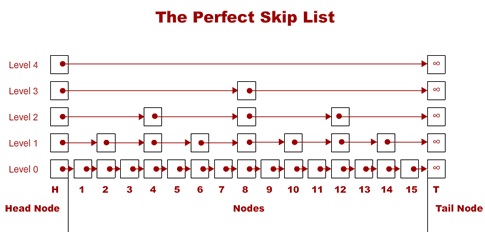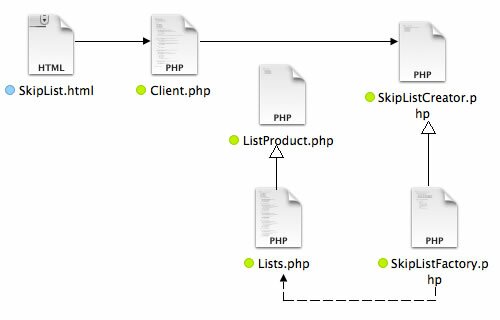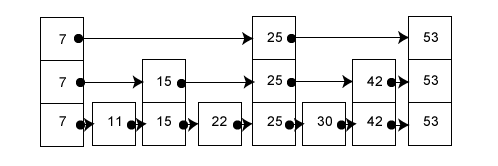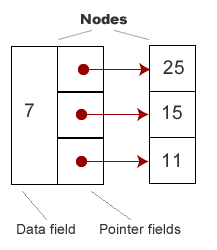 The Perfect Skip List
The Perfect Skip List
I ran across the perfect skip list in a presentation by Eileen Kraemer, a computer science professor at the University of Georgia. (You can find several academic papers on the perfect skip list if you do a Web search: key = perfect skip list.) In the most simple terms, the perfect skip list is one where each level has exactly double the nodes as the one above it. In a sense, it is arranged like a binary search. The head node (far left) has a value of minus infinity using the PHP constant with a minus sign (-INF) and the node on the far right has a value of infinity, (INF). (I’m calling the far right node the tail node for the sake of symmetry. You’ll also see it labeled the “sentinel.”) By having the highest and lowest possible values bracketing the search values, it contains the search parameters so that you can enter any values you want in the skip list. Figure 1 shows the perfect skip list without values except for the tail node with a value of infinity.

Figure 1: Perfect Skip List
That looks a lot like the train lines used in the previous post on skip lists, and if it helps to visualize the skip list as train lines to see what’s going on, you can think of them as such. Figure 1 also may remind you of a binary search pattern, and that’s because perfect skip lists and binary searches have a lot in common. All that’s left to do is to program it. First, though, give it a quick play and download the files:
Programming Skip Lists with the SplDoublyLinkedList class
Most of what you need to know about programming linked lists can be found in the post on Linked Lists on this blog. Using the built-in PHP SplDoublyLinkedList class (PHP 5.3+), I generated five linked lists, naming them level4 to level0, reflecting those in Figure 1. The trick was in figuring out how to best iterate through the lists. Here’s the iteration process I was looking for:
- Start with level4 and check the first node to the right
- If less than move down one level; greater than move right
- Synch list nodes with levels
- Repeat until match found
Initially, I tried using the next() and prev() methods in the SplDoublyLinkedList class, but it was very difficult to synch all levels with those methods. Then I tried using the offsetGet(n) method, and it worked easily and well for both searching and synching levels.
The Skip List Product and Factory
A Factory Method design pattern serves to create the linked lists and final skip list. Figure 2 shows the class diagram in file format:

Figure 2: File Diagram of Skip List Factory Method pattern
The Client makes all requests through the factory for linked lists. The lists themselves have been configured as implemented products, and the Client puts them together as a skip list. An alternative design would have been to have a fully loaded SkipList class (an encapsulated skip list) and have the Client pass on search requests with the search methods in the SkipList class instead of the Client. Either way, the Factory Method has ensured loose binding, and so if you’d like to experiment with a separate skip list class, go ahead. (Click below to see how the different objects are implemented.)
Continue reading ‘PHP Skip Lists 2: Implementing Skip Lists in PHP’
 A few years ago I created a post on Skip Lists (different blog), and several people told me that it clarified the concept of skip lists for them; so I’m reproducing it here for PHP developers. Using the analogy of rail travel in the New York-Hartford-Boston area, I show how the skip list can work in the world apart from programming. Living in Bloomfield, Connecticut, I’m about halfway between Boston and New York City. Lately they’ve been talking about building a high speed rail to Hartford and on to Springfield, Massachusetts. Naturally, when thinking about such a rail system, I like to think that the really fast part of the trip would be between New York City, Hartford, and Boston. Of course they’d need an express to stop off in New Haven and Springfield. Further, lots of other towns, including Bloomfield, would need some kind of local line. Left to my own devices, I would build the following lines:
A few years ago I created a post on Skip Lists (different blog), and several people told me that it clarified the concept of skip lists for them; so I’m reproducing it here for PHP developers. Using the analogy of rail travel in the New York-Hartford-Boston area, I show how the skip list can work in the world apart from programming. Living in Bloomfield, Connecticut, I’m about halfway between Boston and New York City. Lately they’ve been talking about building a high speed rail to Hartford and on to Springfield, Massachusetts. Naturally, when thinking about such a rail system, I like to think that the really fast part of the trip would be between New York City, Hartford, and Boston. Of course they’d need an express to stop off in New Haven and Springfield. Further, lots of other towns, including Bloomfield, would need some kind of local line. Left to my own devices, I would build the following lines:



 Figure 5: Node with multiple pointers
Figure 5: Node with multiple pointers
Recent Comments